
Exploring the Seminole Tribe’s Unique Partnership with the FSU Seminoles
Here in Florida, the Seminole Tribe and the Florida State University Seminoles are in a unique partnership. For almost 80 years FSU has been using the Seminole name as a homage to the unbreakable, unconquered spirit of the Florida Seminoles. But, how did this relationship come about? And how is this partnership navigated in the 21st century? This week, join us for a deep dive into the good, and the controversial, connections between the Florida State University Seminoles and the Seminole Tribe of Florida over time.
In our featured image this week you can see this year’s 25-26 Seminole Princesses Bailey Marie Latchford (Miss Florida Seminole, left) and Chaka Yani Smith (Jr. Miss Florida Seminole, right) at the Florida State University Homecoming game on November 1, 2025. Photo by Beverly Bidney via the Seminole Tribune.
How long has Florida State University been calling themselves the Seminoles?
Florida State University adopted the name “Seminoles” in 1947 to represent their various sports teams. Students at the time voted on more than 100 names, which included a variety of options such as the “Crackers, Statesmen, Tarpons and Fighting Warriors.” Interestingly, Florida State became the FSU Seminoles an entire decade before the Seminole Tribe of Florida was federally recognized by the United States Government in 1957.
Students chose the name to honor the Seminoles of Florida and their unconquered history. On the Florida State University website, they emphasize that “By calling themselves Seminoles, members of the FSU community are engaging in a tradition of tribute for a people whose indomitable spirit is one that is deserving of honor. This university honors the bravery, courage, strength and determination of a people who never surrendered, who persevered to safeguard their heritage and traditions.”
The Seminole Tribe of Florida’s influence on FSU and the University’s use of the “Seminole” moniker did not begin until the late 1970s. Up until that point there was a vast array of imagery that is blatantly appropriative by even the loosest standards. The university stresses that “These are no longer acceptable or used, and it was during the 1970s that early consultations between the University and the Seminole Tribe evolved into the partnership we nurture today.” The Path to Partnership between FSU and the Seminole Tribe of Florida began after pressure in the form of student led protest, and informal and formal conversations by the Tribe convinced the University to change how Seminoles were depicted. Slowly, FSU “increasingly invited Seminoles to attend campus functions, having them serve as dignitaries at various events and recognizing their achievements with honorary degrees. [They] acknowledged that its earlier representations were ill-suited to represent a modern university.”
A Partnership Blossoms
In 1972 the Seminole Princesses would for the first time attend an FSU Homecoming game as official representatives of the Seminole Tribe of Florida. This tradition continues to this day, with the reigning Miss Florida Seminole and Miss Jr. Florida Seminole crowning the Homecoming court. They are now accompanied by a delegation of Tribal officials, as well as family members. These first few fledgling steps toward a partnership made an impact on the university immediately, shifting the acceptable iconography with Tribal input. In 1976 the Homecoming court would change from being crowned with non-Seminole headdresses to culturally appropriate turbans. With direction from then-Chairman Howard Tommie, FSU began the tradition of Osceola and Renegade in 1978.
By the 1980s the relationship between the Seminole Tribe and FSU was becoming more solid, while broader discussions throughout the country aimed a laser focus on the use of Native American imagery and names for sports teams. In 1982 Chairman James E. Billie made clear that the Seminole Tribe of Florida was a sovereign nation, and only they had the agency to deem FSU’s use of the Seminole name and image appropriate or not. In the 1990s Billie would double down on this stance when he “publicly endorse[d] FSU’s use of the name ‘Seminoles’ in a letter to the FSU Alumni Association. Once again, the Tribe insisted that it had the right to speak for itself.”
The 2005 Resolution
2005 brought a renewed discussion around Native American imagery, iconography, and use of names ignited after the NCAA initiated a new policy. The policy “prohibits NCAA colleges and universities from displaying hostile and abusive racial/ethnic/national origin mascots, nicknames or imagery at any of the 88 NCAA championships.” Continuing on their previous actions, the Seminole Tribe of Florida asserted that they, and they alone, could deem FSU iconography inappropriate.
In response, Seminole Tribal Council unanimously passed a resolution which upheld FSU’s right, in their eyes, to continue the use of the Seminole name and associated imagery. Within the resolution, the Tribal Council “further extends an invitation to Florida State University and its officials to continue their relationship and collaborate on the development of logos and nicknames that all members…can be proud of.” The resolution convinced the NCAA to reassess certain relationships and the use of Native American imagery, a privilege few college institutions enjoy.
Immediately following the 2005 Resolution, FSU and the Seminole Tribe of Florida worked hard to renew and strengthen their relationship, which can clearly be seen today. Through incremental changes over the last few decades, FSU has continued to reevaluate and reassess names, policies, imagery, and traditions. They have abandoned some and augmented others with direction from the Seminole Tribe of Florida and remain committed to “collaborate and ensure that the relationship is built on mutual respect and friendship. Every FSU student, alumnus, and fan is responsible for maintaining and respecting this relationship.”

The Seminole Tribe of Florida’s leadership and Provost Jim Clark with The Marching Chiefs and Osceola & Renegade at the 2025 Brighton Field Days Festival, February 2025.
Florida State University Seminoles in The Museum Collection
By perusing the Ah-Tah-Thi-Ki Museum Online Collection, you can quickly see that many Tribal members have been active participants in FSU Seminoles sports for decades. Below, you can see Bobby Bowden holding an infant for a posed photo in front of a framed 1993 Florida State football team photograph that features “National Champions” on a placard below the photo. The infant is holding up an index finger as to denote “#1,” much to the apparent delight of Bowden.
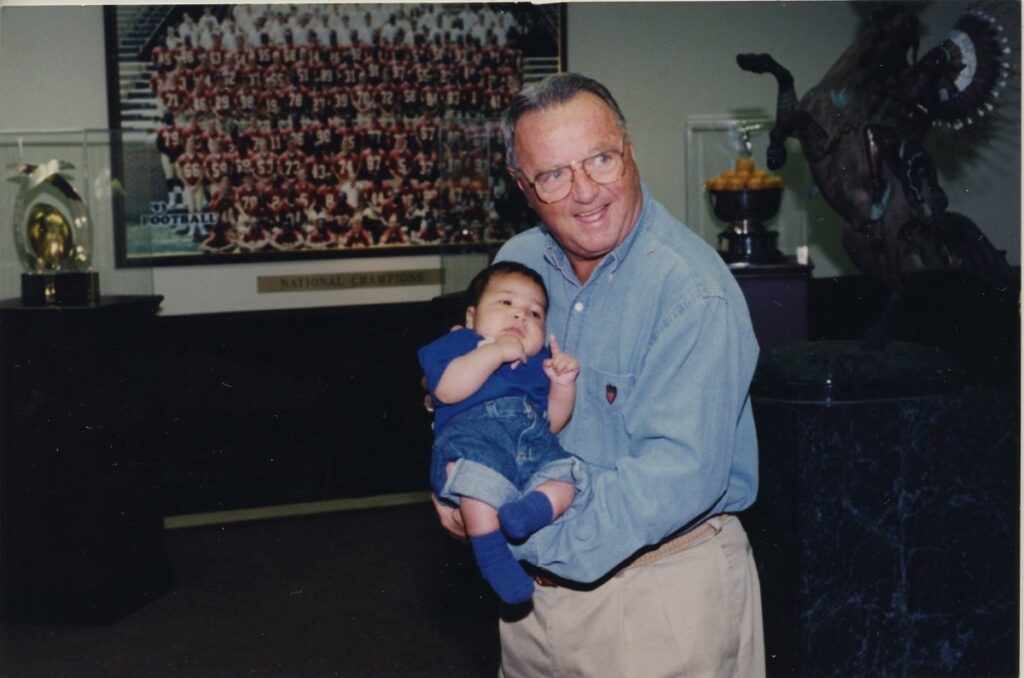
2015.6.18000, ATTK Museum
Bobby Bowden was a legendary Florida State University football coach who led the Seminoles to two national championships (1993 and 1999) as well as 12 Atlantic Coast Conference Championships. Bowden coached the Seminoles from 1976 until 2009 and is considered one of the best college football coaches of all time. Bowden shows up multiple times in the online collection, usually posing with young high school visitors or game attendees.
Below, Bowden poses in his office with visiting students from the Brighton Reservation on March 24, 1998. From left to right, Tiffany Youngblood, Neil Baxley, Earle Snow, Duane Jones (standing behind Snow), Jeff Osceola, an unidentified young man, and Louise Gopher. Another young man sits in a red leather chair in front of the desk.

2023.25.1809, ATTK Museum
Seminoles on the FSU ‘Noles
Tribal members have also not been a stranger to ‘Noles athletics. This year there are two Tribal Members on the FSU athletic roster: Xavier Osceola and Zae Thomas. Additionally, Kenna Martinez competes in the wrestling club.
Xavier Osceola
From Hollywood, FL Xavier Osceola is a freshman guard on the men’s basketball roster. He previously played for Nova Southeastern University school, where he was team captain his senior season. In 2024 Osceola and the Seminole Tribe of Florida Men’s team would finish fourth at the Battle of the Nations, an all-Native basketball tournament.
Osceola’s grandfather, Joe Dan Osceola, also has a connection to Florida State University. FSU offered Joe Dan a scholarship back in 1957. Although he would ultimately decide to go elsewhere, he did visit the school and consider the offer. Below, you can see Joe Dan Osceola with Coach Tom Nugent on the FSU Football field. Osceola had visited the school to interview for his enrollment under an athletic scholarship.
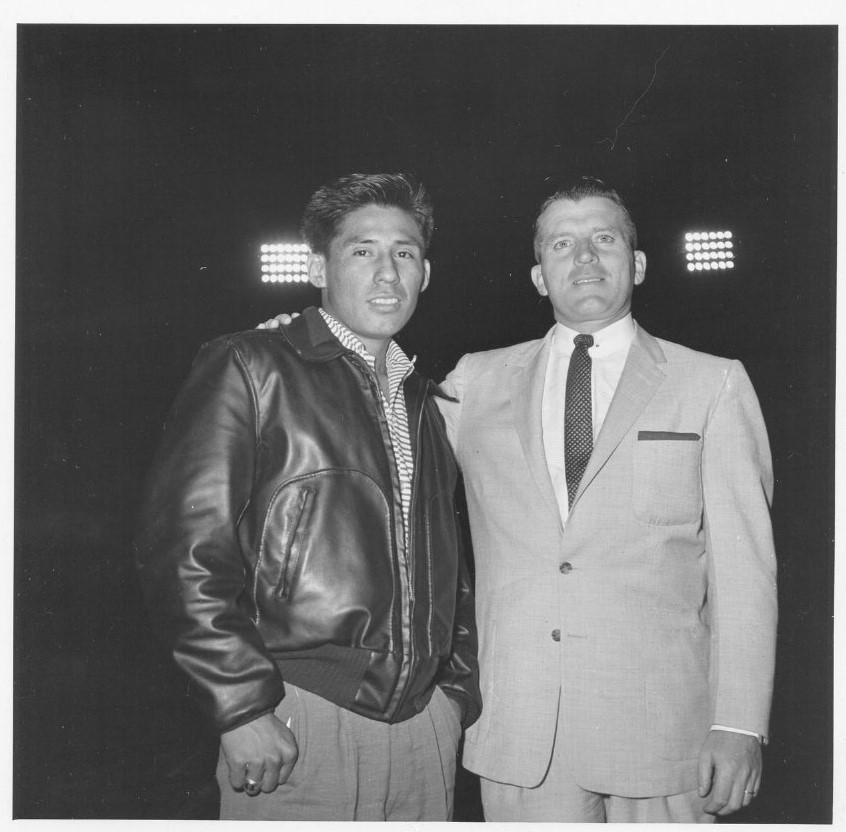
2009.34.356, ATTK Museum
Xavier Osceola is believed to be the first Seminole Tribe of Florida member to play National Collegiate Athletic Association (NCAA) Division I (D1) basketball. In an interview in FSView, Osceola talked about his achievements, and what it means to him to be a Seminole Tribal Member at FSU: “Every time I walk in the gym, I definitely carry a sense of pride with me. Just really proud to represent not only me and my family but also my people. Not just Seminoles but Native Americans all across the country.” He continued: “I wear this jersey with a lot of pride, being the first Seminole, that’s something I try to remember. I’m glad to be here and I can’t wait.”
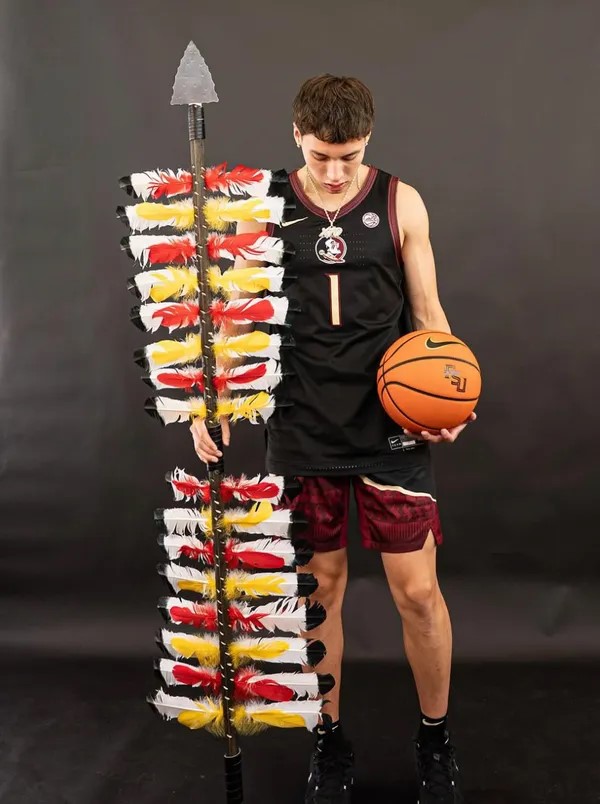
Xavier Osceola via FSView
Greg “Zae” Thomas
Another Seminole on the current FSU athletic roster is Greg “Zae” Thomas. A knockout football star, Zae played high school football for American Heritage High School in Plantation, FL. Thomas is one of only two Seminoles who have played football for FSU. Justin Motlow was a wide receiver and preferred walk-on from 2014–2017. Thomas made his own mark on history by being the first to officially sign a full scholarship offer to play for FSU.
Only a year before graduation, Thomas didn’t have a single college offer. After his historic signing, he recalled how much work and dedication went into football that year. “I just got to put my head down and block out all distractions,” Thomas said. “It’s going to be boring and seem lame, and you’re not going to do a lot of things other people do, but hard work pays off. A cliché, but its true.” Thomas is a lifelong FSU fan, sharing in a Seminole Tribune article about his historic signing that “It means everything. It’s a dream come true.”

For Thomas, being a Seminole means a lot to him. He chose FSU over more than 30 other top-tier programs including Clemson, Miami, LSU, and Penn State. In an interview with Inside South Florida, Thomas shared how important that is for him. He said “I am actually a part of the Seminole Tribe, so um it’s a blessing from that part being able to represent a lot of people and be a role model.” He would continue on that “A lot of people looking up to me, that’s something I need to keep in mind. That’s extra special.”
OB Osceola III
Although not currently at FSU, the future 2026 graduate OB Osceola III has already committed to playing for FSU’s baseball team next year. He will become the first Seminole to play baseball for FSU. “It means a lot with the heritage,” said Osceola in a Seminole Tribune article from 2023. “Especially me as a Seminole, I try my best to symbolize some type of warrior out there on the mound.” A life-long FSU fan, Osceola recalls watching games with his father as a child. He continued with “I can’t wait to get to Florida State.”
“It was a very proud moment for him, for myself, for our family and probably for the tribe,” said OB’s father, OB Osceola Jr., about OB Osceola III’s verbal acceptance of FSU’s offer. He and his own father, OB Osceola Sr. were there to witness the acceptance. He comes from a sports-oriented legacy. His grandfather OB Osceola Sr held a record for no-hitters from Everglades City High School. His uncle, the late Harry Billie who was discussed in the last post was a minor league baseball player in the 1960s.
From Naples, FL Osceola is finishing his final high school year this year, with intentions to go straight to FSU in Fall 2026. OB Osceola III officially signed on the FSU 2026-2027 roster on November 12, 2025.

OB Osceola III delivers a pitch for Community School of Naples. (CSN photo via the Seminole Tribune)
Homecoming and the Seminole Princesses
The evolving relationship with the Seminole Tribe of Florida and FSU has resulted in many Tribal officials and members becoming representatives and valued visitors during major university events. None is more beloved than the Seminole princesses crowning the Homecoming court. Each year at homecoming the reigning Miss Florida Seminole and Miss Jr. Florida Seminole act as representatives for the Tribe and are an integral part of the Homecoming festivities. They also crown them in culturally appropriate Seminole turbans, made by Seminole Tribal members.
The very first Miss Florida Seminole to crown the Homecoming court was Connie Gowan. She was the very first official Miss Florida Seminole in 1957, although she did not crown a Homecoming court until the 1980s. “Chairman [James E.] Billie said FSU wanted someone to represent the tribe at homecoming. He didn’t ask me, he just told me I was going to represent,” Gowen said with a laugh in a Seminole Tribune article. In that very first crowning, she walked the path with Larry Frank, her son. In 2021, thirty years after that historic Homecoming, she would walk again with Kyle Doney, Tribal member and FSU alumni. You can see their historic walk below.
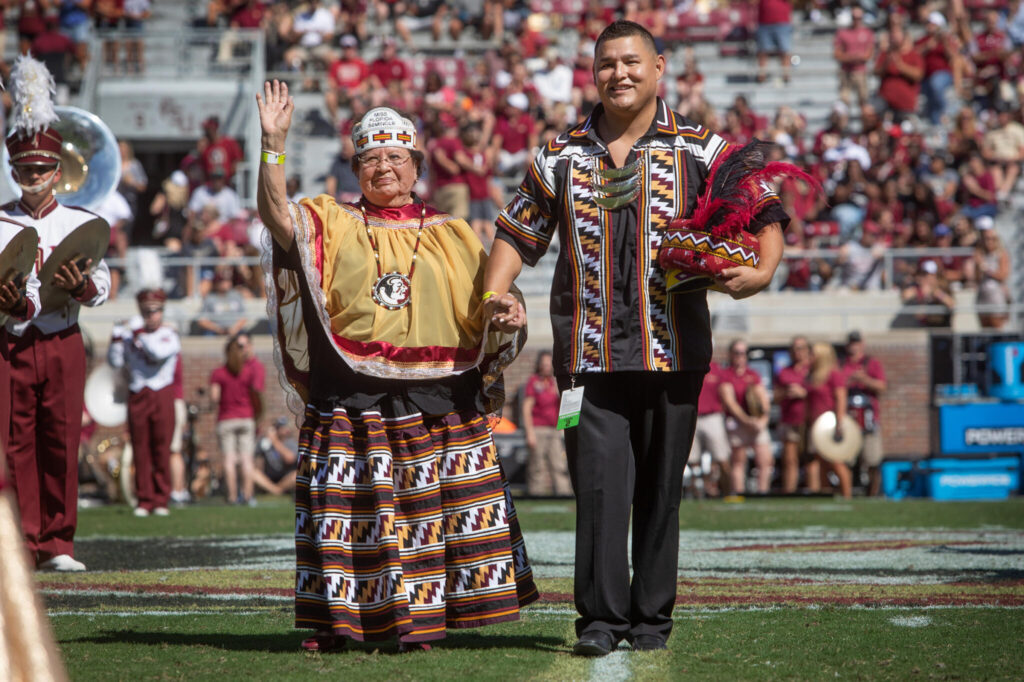
Homecoming Ceremony
2021
For years, Gowan said that various Tribal officials performed the crowning until she suggested Seminole royalty. Since then, the Princesses have crowned the FSU Homecoming court. You can see this year’s reigning princesses in our featured image.
The New Native American and Indigenous Studies Center
Just last year a brand new Native American and Indigenous Studies Center opened on the FSU Campus. It was developed with not only the Seminole Tribe in mind, but all Native Americans and those committed to amplifying and honoring Indigenous voices. At the opening dedication ceremony on November 22, 2024 a number of representatives from the Seminole Tribe of Florida were present.
Chairman Marcellus Osceola Jr. shared that “These are the small steps that we’re taking to help promote (our tradition and history) with the university. I commend you, President McCullough and Dr. Frank, for all you’ve done. Other universities are taking notice throughout the country because this isn’t just for the Seminole Tribe – this is for all Indigenous peoples throughout the world.”
Bailey Marie Latchford, who is the current reigning Miss Florida Seminole, spoke at the dedication. She is also an FSU student, double majoring in social work and criminology. She shared that “My hope is that this center becomes a sanctuary for Indigenous students and a motivating factor for future tribal students to choose FSU, seeing it as a place that truly values our cultures and traditions.”

Bailey Marie Latchford at the NAIS Center dedication, November 2024.
The “Mascot” in the Room
It would be hard to have a conversation about the Florida State University Seminoles without addressing conversations and controversies around Native American imagery and sports teams. Famously, some teams (such as the now-named Washington Commanders) even completely rebranded after reflection on the origins of their team name. But, the Florida State University Seminoles have a partnership with the Seminole Tribe of Florida, as we have discussed in depth above.
The Florida State University website explicitly states that “The Florida Seminoles are our partners, not our mascots. The Seminole Tribe of Florida ensures that any display of its culture and symbols are consistent with both the Tribe’s and the university’s values. Seminoles design and create the authentic apparel worn by the FSU students portraying Osceola. These appearances adhere to the official wishes of the Seminole Tribe of Florida. As partners, we engage in continuous conversation regarding this symbolic representation.”
Does that change the narrative for their use of Osceola, Renegade, and other less savory traditions such as the War-Cry (added in 1984) or the “Chop?” Unsurprisingly, even with the endorsement of the Seminole Tribe of Florida government, many are unhappy with the representation of Osceola and other FSU iconography. Recently, Indigenous TV shared a social media post about the 50-year Osceola and Renegade tradition, detailed in an AP article. The response was incredibly mixed and even included derision from Seminoles themselves. Below, you can see a selection of responses to that post, from both Florida Seminoles and beyond.
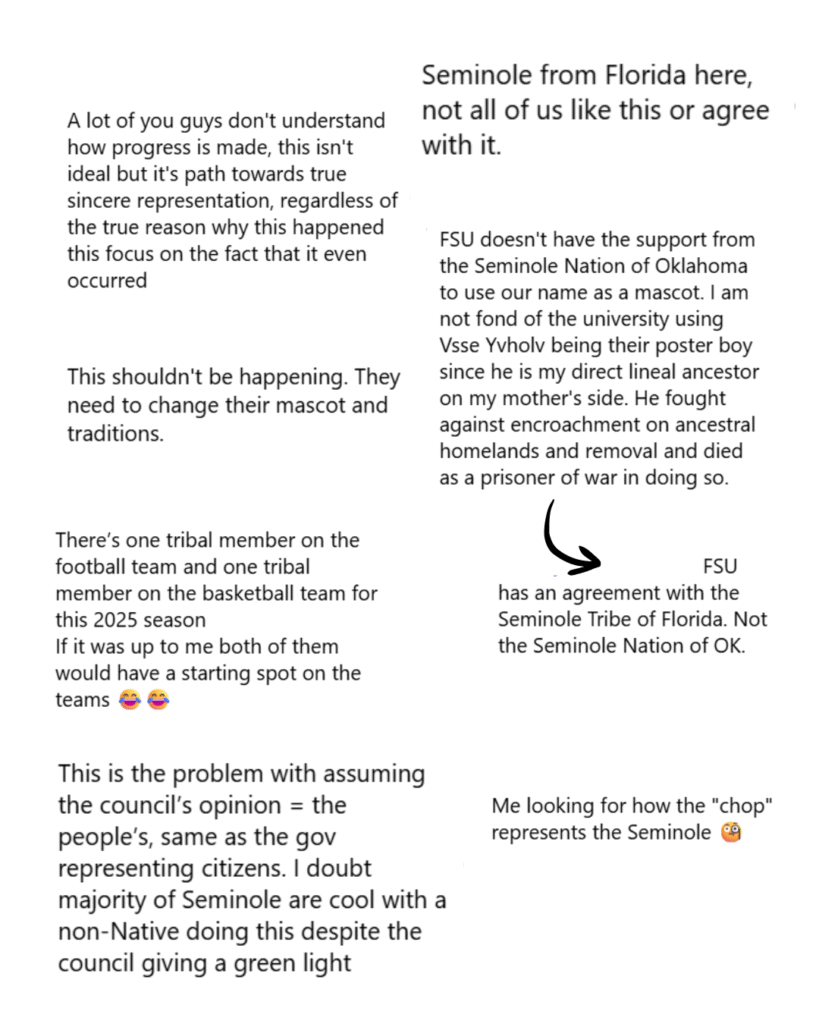
Continuing Conversations
Feelings about FSU’s use of Osceola’s name, the Osceola and Renegade tradition, and other aspects of the Seminole representation are incredibly mixed. While some Tribal members are in full support, others bring up valid concerns about appropriation and acceptable representation of Seminole imagery. While the official stance of the Seminole Tribe of Florida is in full support, these concerns and critiques should also be taken into account and add to the broader conversation around appropriation, use of Native American imagery, and the intricacies of what it means to honor and respect Indigenous cultures.


